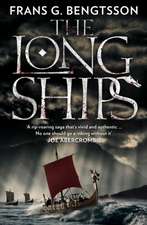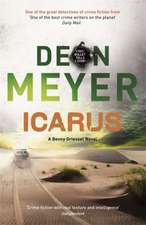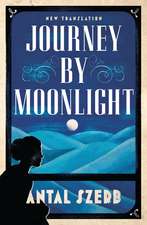Chronicler of the Winds
Autor Henning Mankell Traducere de Tiina Nunnallyen Limba Engleză Paperback – 31 mai 2007 – vârsta de la 14 până la 18 ani
In the hot African night a single gunshot cracks the silence. José Antonio traces the sound to the stage of the local theatre company, where he finds Nelio, the young prophetical leader of the city’s street kids, crumpled in blood. Nelio refuses to be taken to the hospital but instead tells Jose his life’s story: how bandits raided his village, his daring escape, and his struggle to survive on the streets. José is irrevocably changed. He becomes the Chronicler of the Winds, revealing Nelios’s magical tale to all who will listen.
| Toate formatele și edițiile | Preț | Express |
|---|---|---|
| Paperback (2) | 99.59 lei 3-5 săpt. | +7.09 lei 4-10 zile |
| Vintage Publishing – 5 apr 2007 | 99.59 lei 3-5 săpt. | +7.09 lei 4-10 zile |
| Vintage Books USA – 31 mai 2007 | 128.33 lei 3-5 săpt. |
Preț: 128.33 lei
Nou
Puncte Express: 192
Preț estimativ în valută:
24.56€ • 25.37$ • 20.44£
24.56€ • 25.37$ • 20.44£
Carte disponibilă
Livrare economică 04-18 martie
Preluare comenzi: 021 569.72.76
Specificații
ISBN-13: 9780307280442
ISBN-10: 0307280446
Pagini: 233
Dimensiuni: 133 x 203 x 19 mm
Greutate: 0.26 kg
Editura: Vintage Books USA
ISBN-10: 0307280446
Pagini: 233
Dimensiuni: 133 x 203 x 19 mm
Greutate: 0.26 kg
Editura: Vintage Books USA
Notă biografică
Internationally acclaimed author Henning Mankell has written nine Kurt Wallander mysteries. The books have been published in thirty-three countries and consistently top the bestseller lists in Europe, receiving major literary prizes (including the UK's Golden Dagger for Sidetracked) and generating numerous international film and television adaptations. He has also published many other novels for children, teens, and adults. In addition, he is one of Sweden's most popular dramatists.
Born in 1948, Mankell grew up in the Swedish village Sveg. He now divides his time between Sweden and Maputo, Mozambique, where he works as a director at Teatro Avenida. He has spent many years in Africa, where a number of his novels are set.
Born in 1948, Mankell grew up in the Swedish village Sveg. He now divides his time between Sweden and Maputo, Mozambique, where he works as a director at Teatro Avenida. He has spent many years in Africa, where a number of his novels are set.
Extras
The First Night
When the shots were fired on that fateful night and I found Nelio soaked in his own blood, I had been working at the bakery of the confused and halfcrazed Dona Esmeralda for several years. No one had lasted there as long as I had.
Dona Esmeralda was an amazing woman; everyone in the city–and they all knew who she was–either secretly admiredher or wrote her off as insane.When Nelio, without her knowledge, lay on the roof of the bakery and died, she was more than ninety years old. Some claimed that she was a hundred, but noone could say for sure. With Dona Esmeralda, nothing was certain. It was as if she had existed for all time; she was one with the city and its founding.
No one could remember her ever being young. She had always been ninety or perhaps a hundred years old. She had always driven around in her ancient car at high speed with the top down, veering from one side of the street to the other. Her clothes had always been made of voluminous silk; her hats were fastened under her wrinkled chin with broad ribbons. It was explained to strangers–who barely managed to avoid being run over by her wild careering–that even though she had always been exceedingly old, she was the youngest daughter of the infamous municipalgovernor Dom Joaquim Leonardo dos Santos, who during his scandal-ridden life had filled the city with innumerable equestrian statues in the various central plazas.
Countless stories circulated about Dom Joaquim, particularly about the vast number of illegitimate children he had fathered. With his wife, the birdlike Dona Celestina, he had had three daughters; Esmeralda was the one who resembled him most, in temperament if not in appearance. Dom Joaquim belonged to one of the oldest colonial families that had come from the other side of the sea in the middle of the previous century. His family had quickly become one of the most preeminent in the country. Dom Joaquim’s brothers had won positions through their prospecting for gems in the remote provinces, as big-game hunters, prelates and military officers.
At a young age, Dom Joaquim had cast himself into the chaotic arena of local politics. Since the country was governed as a province from across the sea, the locally appointed governors could generally do as they pleased; no one had any opportunity to keep an eye on what they were up to. On those few occasions when suspicion grew too great, government officials would be dispatched from across the sea to find out what was actually going on within the colonial administration. Once Dom Joaquim filled their offices with snakes; another time he installed a number of wild drummers in a neighboring building, whereupon the government officials either flew into a rage or lapsed into a deep silence and then departed as soon as they could find passage to Europe. Their reports had always been reassuring: all was well in the colony. In recognition of which, Dom Joaquim would stuff little cloth bags of gemstones into their pockets as he bade them farewell at the dock.
Dom Joaquim was first elected municipal governor when he was no more than twenty.His opponent, a kindly and credulous old colonel, withdrew from the race after Dom Joaquim cunningly spread a rumor that the man had been convicted of unspecified crimes in his youth, when he was still living on the other side of the sea. The accusations were false, but the colonel realized that he would never be able to extinguish the rumors and gave up. As in all other elections, fraud was the fundamental organizational assumption, and Dom Joaquim was the winner by a majority that far exceeded the number of registered voters. The principal element of his campaign was a promise, if he were elected, to increase dramatically the number of local holidays, which he implemented immediately after he had been sworn in and appeared for the first time on the steps of the governor’s residence wearing the plumed tricorn hat, the symbol of his new, democratically achieved eminence.
Dom Joaquim’s first act as newly elected governor was to order a large balcony to be built on the façade of the palace from which he could address the citizenry on appropriate occasions. Since he had been legitimately elected, he took pains to ensure that no one could challenge his position as governor, and he was reelected over the next sixty years by an ever growing majority, in spite of the fact that the population decreased drastically during this period.When at last he died, however, he had not been seen in public for a long time. He was so confused by then and had sunk so far into the haze of old age that sometimes he imagined he was dead, and at night he would sleep in a coffin standing next to his wide bed in the governor’s palace. But no one had the courage to question the wisdom of his continuing as governor; everyone feared him, and when he did finally die–hanging halfway out of his coffin, as if he had wanted to crawl out to the balcony one last time and look over the city which he had transformed beyond recognition during his long years in power–no one dared do anything until several days later when, in the stifling heat, he began to smell.
He was Dona Esmeralda’s father, and she was just like him. When she raced through the city in her open convertible, she
would see everywhere the mighty statues crowding the plazas, and every one of them reminded her of her father. Dom Joaquim had always been on the lookout for the least sign of revolutionary discontent and unrest. In his early years he had appointed a body of secret police, a unit which everyone knew about but which officially did not exist. Their only task was to mix with the people and listen for the tiniest hints of unrest. At the same time, Dom Joaquim took quick action whenever a revolution in a neighboring country threw the current despots into prison, drove them into exile, or put them in front of a firing squad. By then he would have already offered a price for the statues that the enraged populace was toppling to the ground. He paid handsomely for them, and they were transported to the city by ship and by rail.The old inscriptions were filed off, and Dom Joaquim ordered his own family name to be engraved on the statues. Since his ancestors were of simple peasant stock from the Mediterranean plains, he felt no compunction about inventing a new family tree for himself. In this way the city became filled with statues of former generals belonging to his family. Since revolutions in the neighboring countries were a regular occurrence, the influx of statues became so overwhelming that Dom Joaquim was forced to build new plazas to make room for his purchases. At the time of his death, every conceivable space in the city was taken up with British, German, French and Portuguese monuments to individuals who were now included in the multitude of generals, philosophers and explorers with which Dom Joaquim, in his inexhaustible fancy, had endowed his lineage.
His daughter, the eternally ninety-year-old Esmeralda, would rush past all these memories of Dom Joaquim and his life in her
frantic quest for a meaning to her own life. She had been married four times, never for more than a year since she would almost at once grow bored, and the men she had chosen would flee, terrified of her violent temper. She never had any children–although there were rumors that she had a son concealed somewhere who would one day make himself known and get himself elected governor as his grandfather’s successor. But no son ever turned up, and Dona Esmeralda’s life continued to shift course in her restless search for something that she never seemed able to define. During this time in the life of the city, which might also be called the era of Dona Esmeralda, colonial war had finally spread to this country too, one of the last on the whole African continent to be so affected. Those young men who had decided to fulfil their inescapable historical destinies and liberate the land from the ever weakening colonial power had crossed the border
to the north and entered the neighboring country, which had already overthrown its past and established its own military
bases, its own university. Later, when the time seemed ripe, the men came back over the border, now fully armed with weapons and self-confidence.
The war started on a dark September evening when a local chefe de posto was shot in the thumb by a nineteen-year-old revolutionary, who would later become the first military commanderin-chief of the independent nation. During the first five years of the war, the country on the other side of the sea refused even to acknowledge that it was going on. In the increasingly transparent propaganda, the revolutionary army was labeled as misguided terrorists, deranged criminosos, and the populace was exhorted to grab them vigorously by the ears instead of listening to their malevolent talk about another time and another world in the offing. Gradually, however, the colonial power was forced to acknowledge that the young men were extremely determined and that they quite obviously had the ear of the disloyal public. A colonial army was hastily dispatched; the soldiers began haphazardly bombing the areas where the revolutionary liberators were believed to have their bases, but without fully appreciating it, they suffered one defeat after another. To the very end, those who had come to the country as colonizers refused to accept what was happening. Even when the young revolutionaries surrounded the capital and stood just a few kilometers outside the black townships, the white colonizers continued to administer and to plan for a future that would never be realized. Only afterward, when their defeat was a fact and the country had proclaimed its independence, were the long rows of white headstones in the cemeteries discovered. There lay the young
boys, often no more than eighteen or nineteen years old, who had come across the sea to take part in a war they never understood, to be killed by enemies they had never even glimpsed.
Chaos erupted in the city. Many of the colonizers fled for their lives, leaving behind their homes, their cars, their gardens, their shoes and their black mistresses; trampling over one another in the departure hall at the airport and fighting for passage on the ships about to leave the harbor. Those with sufficient foresight had exchanged their money and possessions for gemstones, now hanging in little cloth bags inside their sweaty shirts. The others left everything behind and departed the country cursing the injustice of the revolutionaries, who had stripped them of all they owned.
Although Dona Esmeralda had never been interested in political matters and was at the time at least eighty years old, she
understood early on, presumably from sheer instinct, that the young revolutionaries were going to win the war. A new age
would arise, and she would be forced to choose which side to be on. It was not difficult for her to grasp that she belonged
with the young revolutionaries.With a mixture of anger and joy she would gladly fight the heavy-footed bureaucracy, which
seemed to be the only thing the colonial power had bestowed upon its distant province. She put on the darkest hat she
owned, possibly meaning to camouflage her treacherous intentions, and drove her car out of the city, taking the north road. She passed through a number of military roadblocks, where the guards tried in vain to make her turn back, warning that she was now entering areas controlled by bloodthirsty revolutionaries who would confiscate her car, tear off her hat, and then slit her throat.When she continued regardless, they concluded that she was crazy, and it was there, at those roadblocks, that the rumor was born which definitively pronounced Dona Esmeralda to be mad.
It is true that she was stopped by the young revolutionaries, but they neither tore off her hat nor slit her throat. On the
contrary, they treated her kindly and with respect. At one of the nearby encampments a commandant questioned her as to why she was traveling all alone in her big open car. She stated briefly that she wanted to enlist in the revolutionary army, and she pulled out of her handbag a rusty old cavalry pistol that had belonged to her father. The young commandant, whose name was Lorenzo and who would later end up in disgrace because of a ferocious lust for other men’s women, sent her on to a base sixty miles farther into the bush to an officer higher up the chain of command who would be better able to determine what should be done about Dona Esmeralda.
This man,whose name was Marcelino and who was a brigadier general in the revolutionary army, was familiar with the old
governor Dom Joaquim. He welcomed Dona Esmeralda, gave her a uniform cap in exchange for her motley hat, and personally handled her briefing in the ideological doctrines of the revolution. Then he sent Dona Esmeralda to a mobile field hospital, where he thought she might do the most good. Under the direction of a team of Cuban doctors she soon learned to assist with complicated operations. That was where she stayed for the rest of the colonial war. When the new leaders at last made their jubilant entry into the city, the populace watched with astonishment as the convertible, which they recognized at once but which they had not seen on the streets for a number of years, reappeared with Dona Esmeralda driving and with one of the revolutionary leaders standing behind her, waving. In the chaos that prevailed during that intoxicating time after the liberation, she was asked by the new president what role she would like to play in the revolutionary transformation of the old society which was now being initiated.
“I want to start a theater,” she replied without hesitation. Surprised, the president tried to persuade her to assume a role
of greater revolutionary moment, but she was insistent. When the president saw that he would not be able to change her mind, he issued a decree, which he later had the Minister of Culture confirm, stating that Dona Esmeralda would be in charge of the city’s only theater building.
The new era had begun. Dona Esmeralda was so preoccupied with her new life that she didn’t seem to notice that the statues, which her father had gone to so much trouble to acquire upon the demise of various dictators, had once again been toppled and were being transported to an old fortress, where they were either stored or melted down. The city, which up until then had been branded by her invented ancestors, was now transformed without her noticing it. She spent all her time inside the dark and decrepit theater, which had long stood abandoned. It had fallen into a sewer-like condition; the stench was horrific, and the rats, as plump as cats, ruled the stage where old sets stood and rotted.
When the shots were fired on that fateful night and I found Nelio soaked in his own blood, I had been working at the bakery of the confused and halfcrazed Dona Esmeralda for several years. No one had lasted there as long as I had.
Dona Esmeralda was an amazing woman; everyone in the city–and they all knew who she was–either secretly admiredher or wrote her off as insane.When Nelio, without her knowledge, lay on the roof of the bakery and died, she was more than ninety years old. Some claimed that she was a hundred, but noone could say for sure. With Dona Esmeralda, nothing was certain. It was as if she had existed for all time; she was one with the city and its founding.
No one could remember her ever being young. She had always been ninety or perhaps a hundred years old. She had always driven around in her ancient car at high speed with the top down, veering from one side of the street to the other. Her clothes had always been made of voluminous silk; her hats were fastened under her wrinkled chin with broad ribbons. It was explained to strangers–who barely managed to avoid being run over by her wild careering–that even though she had always been exceedingly old, she was the youngest daughter of the infamous municipalgovernor Dom Joaquim Leonardo dos Santos, who during his scandal-ridden life had filled the city with innumerable equestrian statues in the various central plazas.
Countless stories circulated about Dom Joaquim, particularly about the vast number of illegitimate children he had fathered. With his wife, the birdlike Dona Celestina, he had had three daughters; Esmeralda was the one who resembled him most, in temperament if not in appearance. Dom Joaquim belonged to one of the oldest colonial families that had come from the other side of the sea in the middle of the previous century. His family had quickly become one of the most preeminent in the country. Dom Joaquim’s brothers had won positions through their prospecting for gems in the remote provinces, as big-game hunters, prelates and military officers.
At a young age, Dom Joaquim had cast himself into the chaotic arena of local politics. Since the country was governed as a province from across the sea, the locally appointed governors could generally do as they pleased; no one had any opportunity to keep an eye on what they were up to. On those few occasions when suspicion grew too great, government officials would be dispatched from across the sea to find out what was actually going on within the colonial administration. Once Dom Joaquim filled their offices with snakes; another time he installed a number of wild drummers in a neighboring building, whereupon the government officials either flew into a rage or lapsed into a deep silence and then departed as soon as they could find passage to Europe. Their reports had always been reassuring: all was well in the colony. In recognition of which, Dom Joaquim would stuff little cloth bags of gemstones into their pockets as he bade them farewell at the dock.
Dom Joaquim was first elected municipal governor when he was no more than twenty.His opponent, a kindly and credulous old colonel, withdrew from the race after Dom Joaquim cunningly spread a rumor that the man had been convicted of unspecified crimes in his youth, when he was still living on the other side of the sea. The accusations were false, but the colonel realized that he would never be able to extinguish the rumors and gave up. As in all other elections, fraud was the fundamental organizational assumption, and Dom Joaquim was the winner by a majority that far exceeded the number of registered voters. The principal element of his campaign was a promise, if he were elected, to increase dramatically the number of local holidays, which he implemented immediately after he had been sworn in and appeared for the first time on the steps of the governor’s residence wearing the plumed tricorn hat, the symbol of his new, democratically achieved eminence.
Dom Joaquim’s first act as newly elected governor was to order a large balcony to be built on the façade of the palace from which he could address the citizenry on appropriate occasions. Since he had been legitimately elected, he took pains to ensure that no one could challenge his position as governor, and he was reelected over the next sixty years by an ever growing majority, in spite of the fact that the population decreased drastically during this period.When at last he died, however, he had not been seen in public for a long time. He was so confused by then and had sunk so far into the haze of old age that sometimes he imagined he was dead, and at night he would sleep in a coffin standing next to his wide bed in the governor’s palace. But no one had the courage to question the wisdom of his continuing as governor; everyone feared him, and when he did finally die–hanging halfway out of his coffin, as if he had wanted to crawl out to the balcony one last time and look over the city which he had transformed beyond recognition during his long years in power–no one dared do anything until several days later when, in the stifling heat, he began to smell.
He was Dona Esmeralda’s father, and she was just like him. When she raced through the city in her open convertible, she
would see everywhere the mighty statues crowding the plazas, and every one of them reminded her of her father. Dom Joaquim had always been on the lookout for the least sign of revolutionary discontent and unrest. In his early years he had appointed a body of secret police, a unit which everyone knew about but which officially did not exist. Their only task was to mix with the people and listen for the tiniest hints of unrest. At the same time, Dom Joaquim took quick action whenever a revolution in a neighboring country threw the current despots into prison, drove them into exile, or put them in front of a firing squad. By then he would have already offered a price for the statues that the enraged populace was toppling to the ground. He paid handsomely for them, and they were transported to the city by ship and by rail.The old inscriptions were filed off, and Dom Joaquim ordered his own family name to be engraved on the statues. Since his ancestors were of simple peasant stock from the Mediterranean plains, he felt no compunction about inventing a new family tree for himself. In this way the city became filled with statues of former generals belonging to his family. Since revolutions in the neighboring countries were a regular occurrence, the influx of statues became so overwhelming that Dom Joaquim was forced to build new plazas to make room for his purchases. At the time of his death, every conceivable space in the city was taken up with British, German, French and Portuguese monuments to individuals who were now included in the multitude of generals, philosophers and explorers with which Dom Joaquim, in his inexhaustible fancy, had endowed his lineage.
His daughter, the eternally ninety-year-old Esmeralda, would rush past all these memories of Dom Joaquim and his life in her
frantic quest for a meaning to her own life. She had been married four times, never for more than a year since she would almost at once grow bored, and the men she had chosen would flee, terrified of her violent temper. She never had any children–although there were rumors that she had a son concealed somewhere who would one day make himself known and get himself elected governor as his grandfather’s successor. But no son ever turned up, and Dona Esmeralda’s life continued to shift course in her restless search for something that she never seemed able to define. During this time in the life of the city, which might also be called the era of Dona Esmeralda, colonial war had finally spread to this country too, one of the last on the whole African continent to be so affected. Those young men who had decided to fulfil their inescapable historical destinies and liberate the land from the ever weakening colonial power had crossed the border
to the north and entered the neighboring country, which had already overthrown its past and established its own military
bases, its own university. Later, when the time seemed ripe, the men came back over the border, now fully armed with weapons and self-confidence.
The war started on a dark September evening when a local chefe de posto was shot in the thumb by a nineteen-year-old revolutionary, who would later become the first military commanderin-chief of the independent nation. During the first five years of the war, the country on the other side of the sea refused even to acknowledge that it was going on. In the increasingly transparent propaganda, the revolutionary army was labeled as misguided terrorists, deranged criminosos, and the populace was exhorted to grab them vigorously by the ears instead of listening to their malevolent talk about another time and another world in the offing. Gradually, however, the colonial power was forced to acknowledge that the young men were extremely determined and that they quite obviously had the ear of the disloyal public. A colonial army was hastily dispatched; the soldiers began haphazardly bombing the areas where the revolutionary liberators were believed to have their bases, but without fully appreciating it, they suffered one defeat after another. To the very end, those who had come to the country as colonizers refused to accept what was happening. Even when the young revolutionaries surrounded the capital and stood just a few kilometers outside the black townships, the white colonizers continued to administer and to plan for a future that would never be realized. Only afterward, when their defeat was a fact and the country had proclaimed its independence, were the long rows of white headstones in the cemeteries discovered. There lay the young
boys, often no more than eighteen or nineteen years old, who had come across the sea to take part in a war they never understood, to be killed by enemies they had never even glimpsed.
Chaos erupted in the city. Many of the colonizers fled for their lives, leaving behind their homes, their cars, their gardens, their shoes and their black mistresses; trampling over one another in the departure hall at the airport and fighting for passage on the ships about to leave the harbor. Those with sufficient foresight had exchanged their money and possessions for gemstones, now hanging in little cloth bags inside their sweaty shirts. The others left everything behind and departed the country cursing the injustice of the revolutionaries, who had stripped them of all they owned.
Although Dona Esmeralda had never been interested in political matters and was at the time at least eighty years old, she
understood early on, presumably from sheer instinct, that the young revolutionaries were going to win the war. A new age
would arise, and she would be forced to choose which side to be on. It was not difficult for her to grasp that she belonged
with the young revolutionaries.With a mixture of anger and joy she would gladly fight the heavy-footed bureaucracy, which
seemed to be the only thing the colonial power had bestowed upon its distant province. She put on the darkest hat she
owned, possibly meaning to camouflage her treacherous intentions, and drove her car out of the city, taking the north road. She passed through a number of military roadblocks, where the guards tried in vain to make her turn back, warning that she was now entering areas controlled by bloodthirsty revolutionaries who would confiscate her car, tear off her hat, and then slit her throat.When she continued regardless, they concluded that she was crazy, and it was there, at those roadblocks, that the rumor was born which definitively pronounced Dona Esmeralda to be mad.
It is true that she was stopped by the young revolutionaries, but they neither tore off her hat nor slit her throat. On the
contrary, they treated her kindly and with respect. At one of the nearby encampments a commandant questioned her as to why she was traveling all alone in her big open car. She stated briefly that she wanted to enlist in the revolutionary army, and she pulled out of her handbag a rusty old cavalry pistol that had belonged to her father. The young commandant, whose name was Lorenzo and who would later end up in disgrace because of a ferocious lust for other men’s women, sent her on to a base sixty miles farther into the bush to an officer higher up the chain of command who would be better able to determine what should be done about Dona Esmeralda.
This man,whose name was Marcelino and who was a brigadier general in the revolutionary army, was familiar with the old
governor Dom Joaquim. He welcomed Dona Esmeralda, gave her a uniform cap in exchange for her motley hat, and personally handled her briefing in the ideological doctrines of the revolution. Then he sent Dona Esmeralda to a mobile field hospital, where he thought she might do the most good. Under the direction of a team of Cuban doctors she soon learned to assist with complicated operations. That was where she stayed for the rest of the colonial war. When the new leaders at last made their jubilant entry into the city, the populace watched with astonishment as the convertible, which they recognized at once but which they had not seen on the streets for a number of years, reappeared with Dona Esmeralda driving and with one of the revolutionary leaders standing behind her, waving. In the chaos that prevailed during that intoxicating time after the liberation, she was asked by the new president what role she would like to play in the revolutionary transformation of the old society which was now being initiated.
“I want to start a theater,” she replied without hesitation. Surprised, the president tried to persuade her to assume a role
of greater revolutionary moment, but she was insistent. When the president saw that he would not be able to change her mind, he issued a decree, which he later had the Minister of Culture confirm, stating that Dona Esmeralda would be in charge of the city’s only theater building.
The new era had begun. Dona Esmeralda was so preoccupied with her new life that she didn’t seem to notice that the statues, which her father had gone to so much trouble to acquire upon the demise of various dictators, had once again been toppled and were being transported to an old fortress, where they were either stored or melted down. The city, which up until then had been branded by her invented ancestors, was now transformed without her noticing it. She spent all her time inside the dark and decrepit theater, which had long stood abandoned. It had fallen into a sewer-like condition; the stench was horrific, and the rats, as plump as cats, ruled the stage where old sets stood and rotted.
Recenzii
“Mankell [is] a master storyteller.”
—The San Francisco Chronicle
“Admirable. . . . [Mankell is] a writer in search of metaphor and meaning. . . . [Which] makes for an elusively compelling narrative voice.”
—The Boston Globe
“Uplifting. . . . Chronicler of the Winds seems to widen his repertory, switching between the nightmarish, the dream-like and the grittily realistic. . . . Mankell evokes a saintliness among those whose brief lives have been tempered by genocide, exploitation and hardship.”
—The New York Times
“Cinematic and theatrical . . . structured by gorgeous moments of text that transcend the page and become vivid images seared onto the imagination.”
—Yale Daily News
—The San Francisco Chronicle
“Admirable. . . . [Mankell is] a writer in search of metaphor and meaning. . . . [Which] makes for an elusively compelling narrative voice.”
—The Boston Globe
“Uplifting. . . . Chronicler of the Winds seems to widen his repertory, switching between the nightmarish, the dream-like and the grittily realistic. . . . Mankell evokes a saintliness among those whose brief lives have been tempered by genocide, exploitation and hardship.”
—The New York Times
“Cinematic and theatrical . . . structured by gorgeous moments of text that transcend the page and become vivid images seared onto the imagination.”
—Yale Daily News
Descriere
On the rooftop of a theater in an African port, Nelio, a ten-year-old boy--a leader of street kids, rumored to be a healer and a prophet and possessed of a strangely ancient wisdom--tells his unforgettable story over the course of nine nights.



















